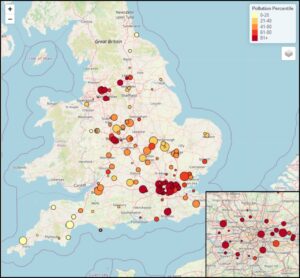Researchers from King’s College London examined air quality at the proposed sites of 147 newly approved schools in England between 2017-2025.
Using air pollution data from Central Office of Public Interest, they recorded PM2.5, PM10 and NO2 levels for every school location (and the nearest approximation for seven greenfield sites which are et to have postcodes) and found 86% of new the proposed sites (126 out of 147) exceeded all three WHO targets, and every location exceeded at least one.

The median PM2.5 reading across all school sites was 10.94 µg/m³ which is more than double the WHO’s guideline of 5 µg/m³.
PM10 showed a median of 17.40 µg/m³ compared to the WHO’s 15 µg/m³, while the median NO2 level was 17.73 µg/m³, comfortably above the WHO target of 10 µg/m³.
The sites with the highest pollution levels were found to be clustered in cities including London, Birmingham, Manchester, and Leeds, while school sites in Liverpool, Bristol, and Newcastle, were found to have lower pollution levels. Locations in Devon and Cornwall had the lowest.
The research team point out that guidance for school proposals does not include any requirement to assess air quality at the proposed location.
They say: ‘We argue that air quality assessment should be mandatory at the proposal and planning stage of any new school building and that national guidance and legislation urgently needs to be updated.
‘New buildings or campuses of existing schools should be given the same consideration and therefore planning regulations also need to be updated to ensure that air quality is included in the public consultation stage and that building and site design minimise the impact of air pollution on children.
.Building regulations must also be updated to emphasise that poor air quality is widespread and significantly detrimental to health,” they insist, adding that two or more WHO air quality breaches should warrant on-site monitoring and expert advice to be sought.
.Unless current recommendations are replaced with mandatory standards, it is unlikely that those proposing or designing new schools will make these assessments.’
They conclude: ‘The public health implications of avoidable childhood exposure to poor air quality could have significant effects on both the quality adjusted life years of the population and financial health expenditure in the United Kingdom. Children deserve protection from avoidable harm while at school.’












